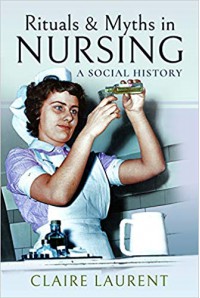A deserved and loving homage to a true caring profession

Thanks to Rosie Croft, from Pen & Sword, for providing me a paperback copy of this book, which I freely chose to review.
This is not the first book about nursing from Pen & Sword that I review, but it seems a particularly appropriate moment to read it and comment on the changes that have taken place in a profession that is right now at the forefront of everybody’s mind. The hard work all the healthcare professionals are doing, at a high personal risk, should not be underestimated, and I hope this health crisis (the coronavirus pandemic) will make governments realise that there are certain things that we should never try to make savings on, because the consequences can be catastrophic. But, let’s talk about the book.
The above description captures perfectly the essence of this book. It is packed full of anecdotes by nursing staff from different generations, as the long list of acknowledgments at the beginning of the book reflects. It is a wonderful combination of fun, bizarre, and touching episodes, memories of uniforms, strange cures (and I’ve heard of some of them, so yes, fashions change over the years), strict cleaning routines that would have made army sergeants proud (including how to make a bed properly), ghosts, cooking breakfast in the wards, what used to pass for medication… all of them steeped up in the social circumstances of the period and reflecting the changes, not only in Medicine and Nursing (from learning on the job, nursing became a university degree, and from tradition and usage they moved onto evidence-based practice), but in society at large. Although I haven’t worked in a hospital for a few years, one of my best friends is a nurse; I have worked and met many nurses, and all the stories rung true for me.
The book includes some wonderful black and white illustrations, a bibliography (with blogs and websites as well as books and articles), a detailed index and even a chart of medical slang. The book is divided into twelve chapters: Without Rhyme or Reason (talking about training and the reasons why women [and later on, men also] decided to go into the job, in many cases out of family tradition); Nurses Who Rustle (uniforms, badges and related items); Handover and Hierarchy (times have changed and the way things are done have also changed, mostly for the better, although there is plenty of nostalgia and some true characters most nurses will never forget); Hygiene and Hijinks (cleaning protocols have changed in so many ways…); Egg White and Oxygen (treatments that had very little, if any, scientific base, but were followed religiously at the time); Bladders, Bowels and Bodily Functions (I don’t think I need to explain this); Medicines and Mystical Powers (this chapter deals not only with medications and drugs that would never be used now and were probably quite dangerous, but also with the procedures and routines imposed in the past that are almost impossible to believe now); Things that go Bump in the Night (ghosts stories… What proper old hospital does not have one ghost or many? And of course, the ghosts of nurses are hard at work ensuring the wellbeing of patients even after death); Dust, Dirt and Domesticity (cleaning protocols past and present); Once the Dust has Settled (gloves, potions, kits…); Theatre theatricals (being in a surgical theatre is an experience as nurses know only too well); Life and Death (births, deaths and everything in between).
This book is a delight. It’s full with many different voices, from different eras, from nurses that had worked in a variety of specialities, all sharing personal stories or stories that they had heard on their jobs. Some are emotional, some funny, and I must warn people who are squeamish about illnesses and bodily functions, as there are some anecdotes that might make them cringe. But anybody who enjoys books about nursing, social history, or just a genuine story with plenty of heart, should read this book. And if you know any nurses or anybody interested in the topic don’t forget to recommend it. It’s a great homage to a profession that has always been and remains, a true caring profession.
 9
9
 2
2







